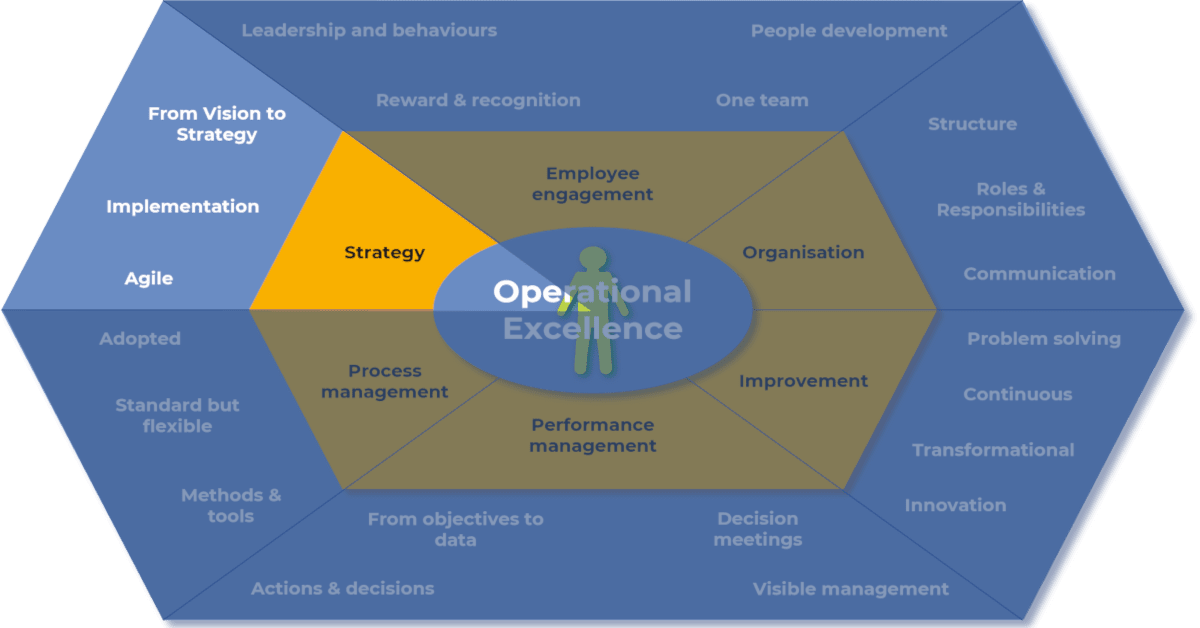Business Strategy Definition Excellence
This page details the Business Strategy Definition Pillar criteria of our Operational Excellence model. The goal is not to explain in great length all of the criteria described here, but to give you enough details to enable you to better evaluate your own definition and deployement of your strategy
Our Business Strategy Definition Excellence Pillar is focused on strategy implementation as it relates to your own organisation's ability to execute it perfectly. It is not about the strategy content itself, since it is ultimately specific to each industry and company.
Ultimately, that could include nearly everything in the operations side of a business. Because of that, we have limited its scope to those "Direct" elements, the VIMOSA elements:
- Vision
- Mission
- Objectives
- Strategic directions
- Action plan

Though this pillar focuses on the Business strategy implementation and not the strategy definition itself, our model does cover the way the strategy is defined on and formulated. Essentially, it's easier to deploy a well-formulated strategy than one that isn't.
This document begins with the vision, mission and strategy definition. The criteria for excellence in business strategy are based on a clear and solid definition of mission, vision and strategy. They must be consistent, communicated, applied and "lived by" through an operational strategic plan with key objectives cascaded across the organisation.
With that in mind, we have identified eight practical criteria for Operational Excellence in the Business Strategy Pillar, themselves broken down into three key areas: "From Vision to Strategy", "Strategy Implementation" and "Agile"
From Vision to Business Strategy Definition

There is often a confusion between the terms "vision," "mission" and "strategy" - so we will define them here as simply as possible.
- The Vision is what the organisation wants to BE.
- The Mission is a high level statement of what the organisation wants to DO.
- The Strategy contains the key paths chosen to ACHIEVE that vision.
The formulation of these three elements in the Business strategy definition must be done in a way that makes them easy to implement and even easier to adhere to by the people within that organisation.
1. Clear and understood Mission or Vision statement
A clearly defined mission or vision statement is a requirement for any organisation. It must always be well communicated but, even more importantly, it needs to be understood by EVERYONE.
People naturally become more engaged and experience higher levels of motivation when they know with both their brain AND their heart that all the effort is worth it and that they are truly going to accomplish something incredible together.
2. Clear and sound Business Strategy definition
The strategy defines how the company will achieve the strategic objectives it has set for itself, as well as the directions chosen in the first place. A "clear" business strategy definition implies that people recognise how this strategy is different from that of their competitors, and that there are real choices being made.
The term "sound" is naturally more difficult to evaluate, since it is about the future and is very specific to your industry. However, the minimal criteria that can be applied involve that some type of robust and documented analysis of the internal and external environment has taken place. This can include but is not limited to a SWOT analysis, competitor and market analysis, differentiation factors, consumer segmentation and more.
Ultimately, this is about making people confident about the business strategy so that they fully adhere to it for each of their behaviour and action.
3. Business Strategic Objectives with the right level of stretch
Clear business strategic objectives, both medium and long-term ones, must be defined for the benefit of the overall organisation. Contrary to common belief, they should not always be ambitious. They must also be adapted to the specific situation the organisation faces, as demonstrated by the excellent article in the Harvard Business Review titled "The Stretch Goal Paradox".
In summary, the objectives should be defined according to the following cases:
- If uncommitted resources ARE available:
- If the recent organisation performance is successful: stretch goals are well adapted.
- If the recent organisation performance is NOT successful: it is best to experiment with a series of "small losses" - tun modest, low risk experiments; even if many may fail, they ultimately yield bigger results than stretch goal in this case.
- If NO uncommitted resources is available, regardless of the recent organisation performance, "small wins" or incremental success strategy is the most adapted
Business Strategy Implementation

The second section, "Business Strategy Implementation," is equally important to the Strategy definition. According to a 2017 study conducted by the Harvard Business Review, a full 67% of well-formulated strategies will STILL fail due to poor execution.
Our own model embeds the popular Hoshin Kanri method. We want to emphasize the importance of the inclusion of a participative process in the implementation. This in itself is the decisive factor for successful business strategy implementation - whether or not people are willing to follow the general direction in this journey the company is about to undertake.
4. Operational Strategic deployement plan
Overall, the Business Strategy definition gives the key directions that will be acted on in the future. It can be detailed, but it must still be complemented by a genuine implementation plan. That one defines the practical actions necessary to take the strategic directions and to reach the defined strategic objectives.
The easiest way to measure the Excellence of such an operational plan is to check for a few of its key elements:
- Someone should be accountable, usually the CEO.
- There should be several work streams, each with their own defined accountable individual.
- There must be a formal project plan with plannings, actions, resources and KPIs to check achievement of the strategic objectives.
- There must be reviews and corrective actions - of course, with a rhythm adapted to a long-term project.
5. Strategic business objectives cascaded and broken down
The objectives of the business strategy are defined as medium and long term objectives. They must be broken down by way of yearly objectives, and budgets must be connected to them. An older study by R. Kaplan revealed that up to 60% of organisations don't actually do this - our recent experience more than corroborates that idea.
Likewise, these objectives must be communicated and cascaded down at each hierarchical level into departmental (team, affiliates, business units...) objectives.
6. Participative process
Though business strategy deployment is primarily a top down process, it must also include a participative process. It guarantees relevant integration with operations, a full understanding and the proper alignment between the different managerial levels.
This process should include collaborative and iterative sessions between two managerial levels. This is invaluable in terms of clarifying the strategy definition, objectives, indicators and all strategic action plans. Such a process is sometimes referred to as the "Catch Ball Process". It comes from a Japanese game in which children playfully throw a ball back and forth.
7. What's In It For Me? (WIIFM)
Though the title of this is playful in nature, it's importance is paramount. The idea is that the impact of the business strategy definition on each organisational area and/or department MUST be identified as early on in the process as possible.
In other words, each individual must understand his or her role in achieving the business strategy. Or at least how their own efforts impact his or her organisation. People need to feel how their work and behaviour are aligned to the business strategy definition. If they are unable to do this, then it is a strong sign that something has been missed in the strategy definition, communication, cascading or even implementation.
Maybe the best example of this is a now-famous story featuring then-President John F. Kennedy and a janitor he encountered while visiting NASA in 1961. Kennedy came across a man who was passionately and enthusiastically mopping the floor. The President stopped to ask him what his job was and the answer was a succinct: "I'm helping to put a man on the moon!"
In that moment, that janitor clearly understood not only the vision of the organisation he was working for, but his contribution to achieving it. If every member of your company doesn't share that same level of clarity, there is a problem that needs to be addressed before you continue.
Agile

8. Agile and adaptable business strategy definition
Finally, we arrive at agility - something that is far more important than most people realise.
The definition of the business strategy, though mid-to-long-term, cannot be static. It MUST be able to adapt to a changing environment, which can include but is not limited to things like new competitors, new regulations, not achieving or even overachieving certain objectives, and more.
These are not ideas that you can control. What you CAN control, however, is how prepared you are in the event that they occur.
Therefore, a mechanism must be in place to regularly review both the strategy implementation progress and the environmental changes taking place. Then, you can adapt the business strategy definition as necessary.
The minimal frequency for this is annual. However, we believe that some elements of the business strategy should be reviewed on a quarterly basis. That implies that the strategy is well cascaded. It has been integrated into the performance management system in all the right ways that you need.
You may also have a look at the next 9 criteria of our Operational Excellence model, in the Process management Excellence pillar.
When you subscribe to the blog, we will send you an e-mail when there are new updates on the site so you wouldn't miss them.



Comments